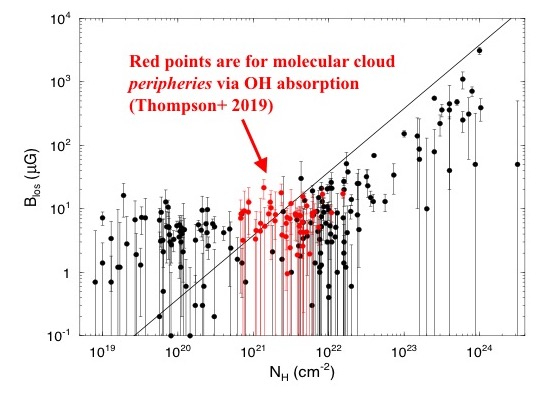| EPoS Contribution |
|
The Role of Magnetic Fields in the Earliest Stages of Star Formation
Thomas Troland U Kentucky, Lexington, US | |
| Galactic Zeeman effect observations have now established the general run of magnetic field strengths as a function of N(H) and n(H) over five orders of magnitude in both parameters. These ranges include both diffuse and self-gravitating gas. Therefore, magnetic field measurements offer insights into the very earliest stages of star formation, namely, the transformation of diffuse gas into self-gravitating gas. Zeeman effect data, including recent data, reveal that this transformation occurs for N(H) ≈ 1022 cm-2 and n(H) ≈ 102.5 cm-3. These values imply a scale of 10 pc. For smaller N(H) and n(H), the gas is diffuse and magnetically subcritical. For larger N(H) and n(H), the gas is self-gravitating and magnetically supercritical (mass-to-flux ratios ≈ 3 times critical). Newly reported Arecibo OH Zeeman observations reveal field strengths in molecular cloud envelopes which, in effect, are the transition regions between diffuse gas and the dense cores where stars form. These results, for locales not previously probed by the Zeeman effect, establish that the cloud envelopes are close to magnetically critical. Therefore, magnetic fields are energetically important in the transition region, even as they become less important relative to gravity as N(H) and n(H) increase in cores of the self-gravitating gas. Evidently, the transition of diffuse gas into self-gravitating gas corresponds to a systematic increase in the mass-to-flux ratio. However, the process by which this increase occurs is not well understood. Possible mechanisms include systematic flows of diffuse gas along field lines, and reconnection diffusion of the field. A clear understanding of the earliest stage of star formation will not be achieved until we understand the processes by which the magnetic field becomes less energetically important as diffuse gas is transformed into self-gravitating, star-forming gas. | |
 | |
| Caption: Line-of-sight magnetic field strengths as a function of N(H) based upon Zeeman effect measurements. Diagonal line represents the critical mass-to-flux ratio. Values above critical (i.e. supercritical) lie below the line and vice versa. | |
| Collaborators: K. Thompson, Davidson College, US C. Heiles, UC Berkeley, US R. Crutcher, UIUC, US |
Key publication
Suggested Session: Magnetic Fields |

